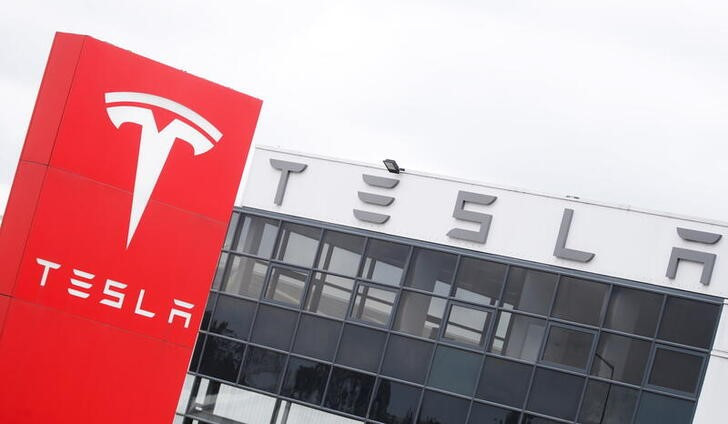On Friday, Tesla stock spiked over 7.4% early in the trading session and is now up 5%, leading the rise in NASDAQ 100 index components. The stock is in its 11th consecutive trading day of gains, with a cumulative increase of over 38% in 11 days.
Tesla's alliances with General Motors and Ford brought a great surprise to the market. Tesla's charging stations are anticipated to dominate North America, and its Full Self-Driving (FSD) technology may be the next collaboration. Additionally, its vehicle tax credits exceeded expectations... There has been a lot of good news for Tesla recently.
Tesla's Charging Stations May Dominate North America
The latest catalyst propelling Tesla's surge is its cooperation with General Motors on Tesla's charging stations. On Thursday, following Ford's recent announcement that its next-generation electric vehicles will adopt Tesla's charging standard, General Motors, another U.S. auto giant, joined the fray. Like Ford, General Motors will begin installing the North American Charging Standard (NACS), used by Tesla, in its electric vehicles from 2025, instead of the current industry standard, the Combined Charging System (CCS).
Analysts generally view Tesla's charging station collaboration with General Motors and Ford positively. Tesla's long-term bull and top-rated Wedbush Securities analyst, Daniel Ives, added Tesla to his "best" list, reiterated his buy rating, and significantly raised his target price from $215 to $300. Ives' target price is currently the highest on Wall Street, over 20% higher than Tesla's price on Friday.
Ives believes that Tesla's cooperation with General Motors makes the sum-of-the-parts valuation method dominant in the current pricing. This includes Tesla's ventures into autonomous driving, supercharging networks, battery ecosystems, solar roofs, insurance, and decisions to expand capacity globally. Cooperation with General Motors could help Tesla monetize its supercharging network better, further increasing its value.
RBC analyst Tom Narayan predicts that Stellantis will also make an announcement similar to General Motors and Ford, partnering with Tesla.
Evercore analyst Chris McNally estimates that by 2030, Tesla's supercharging network could generate $4 to $6 billion in revenue, with $1 to $1.1 billion in revenue from non-Tesla customers.
FSD Technology May be the Next Collaboration
A few days ago, as a pioneer in the autonomous driving field, Elon Musk was "thrilled" when he heard Ford CEO Mary Barra praise Tesla's technology. He responded on Twitter that Tesla has always been committed to helping other automakers and is willing to license Autopilot or Full Self-Driving (FSD) to other automakers.
In a recent CNBC interview, Musk said that the moment for autonomous driving is accelerating. He believes that once FSD crosses a certain threshold in model scale and data accumulation, it will start to explode in growth, much like ChatGPT. Almost instantly, 3 million, 5 million, or even 10 million cars could achieve full autonomy. Currently, no automaker or tech company can be said to be second only to Tesla.
At the Tesla shareholder meeting last month, Musk spoke about FSD, stating that development is progressing rapidly, but he again emphasized that achieving true full autonomy will take some time.
With the implementation of Tesla's cooperation with giants like Ford in the charging station field, Musk's idea of licensing FSD to other automakers has undoubtedly sparked market imagination.
Vehicle Tax Credits Exceeded Expectations
This week's news revealed that all of Tesla's Model 3s are miraculously eligible for the full $7,500 consumer tax credit provided by the U.S. federal government's Inflation Reduction Act, shocking many. Previously, only the Model 3 RWD and Model 3 AWD Long Range with Lithium Iron Phosphate batteries from China's CATL were eligible for half ($3,750) of the tax subsidy.
It is speculated that Tesla may source battery critical minerals from whitelist countries like Australia or Canada while still using CATL's battery cells.
Specifically, Tesla can source battery critical minerals like lithium from Australia or Canada, thereby complying with the origin of mineral raw material requirements in the Act. Moreover, purchasing battery cells from China and assembling battery packs in the U.S. - rather than directly importing battery packs from China - allows for more than 50% of the value-added part of the battery pack to occur in the U.S., which also meets the Act's requirements. Some analysts believe that Tesla may have already begun to manufacture these battery packs in the U.S., still using CATL's battery cells.
The Inflation Reduction Act allows electric vehicle manufacturers to use another method to calculate the content of critical minerals. According to regulations, Tesla "can calculate the average qualified critical mineral content of vehicles from the same model line, factory, category, or a combination of these over a limited period (e.g., a year, a quarter, or a month)." In other words, if Tesla manufactures enough eligible Model 3 batteries domestically, it can offset the non-compliant portion of the Model 3 RWD from CATL.
Wall Street cautiously optimistic about Tesla
Across Wall Street analysts, they maintain a cautiously optimistic attitude towards Tesla stock, including 15 buy ratings, 10 hold ratings, and 4 sell ratings.
However, the current average target price for Tesla among analysts is $194 per share, a few dollars higher than recently, but still far below Tesla's stock price on Friday. Just a few weeks ago, Tesla was hovering around the $185 mark, very close to the analysts' average target price.
Apart from giving a target price of $300 on Friday, bullish analyst Ives candidly said that in this broader green wave of electric vehicles, Tesla is playing chess, while other automakers are just playing checkers.






